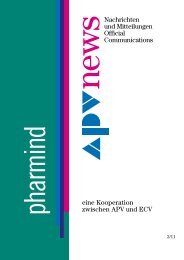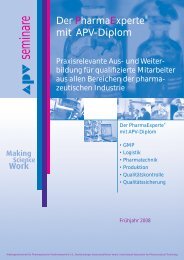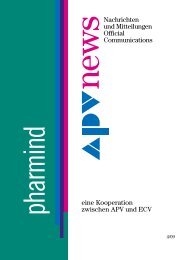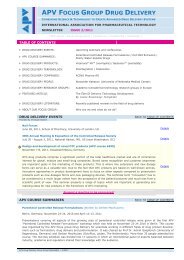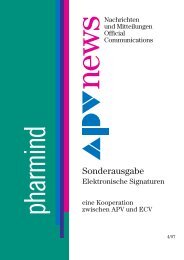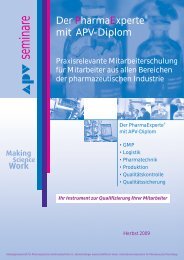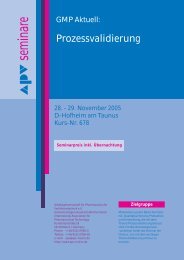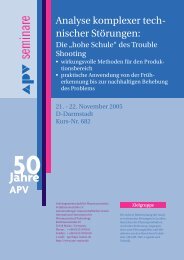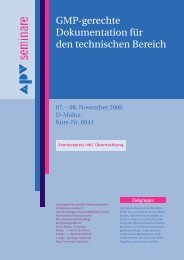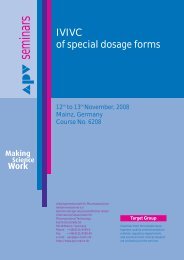APV FOCUS GROUP DRUG DELIVERY
APV FOCUS GROUP DRUG DELIVERY
APV FOCUS GROUP DRUG DELIVERY
Create successful ePaper yourself
Turn your PDF publications into a flip-book with our unique Google optimized e-Paper software.
Slitting lines<br />
Master rolls which are generated after coating, drying<br />
and laminating are slit to narrow rolls which are<br />
subsequently transferred to the converting line. A critical,<br />
dose-generating role is only included, if products<br />
are cut rectangular in the same width. Nearly all transdermal<br />
systems are dosed in the subsequent converting<br />
step.<br />
Converting lines<br />
Converting lines may be continuous, rotary-tool based<br />
or punching-intermittent in their design. Intermittent<br />
designs accept comparatively simple die-cutting tools<br />
which provide a well-described, exact pre-defined area<br />
and can be easily replaced and changed. As punching<br />
occurs in the non-moving phase of the line action, the precision of dosing is very robust and not impaired by machine<br />
speed. Rotary processes, however, require precise, product-specific and more expensive tooling which needs a<br />
comparatively long time for set-up before production but pays back in higher and reliable speed.<br />
Process validation relies on engineering and<br />
machinery-driven IQ/OQ and the productoriented<br />
PQ (process qualification). Challenges<br />
of critical parameters in a fully qualified environment<br />
in which processing steps are tested<br />
under borderline conditions should nowadays<br />
be performed under the more flexible conceptual<br />
approaches of design-of-experiments<br />
(DOE) and adequate reporting. Formal validation<br />
batches need to be executed and tested at<br />
target conditions and full industrial size.<br />
Future<br />
For decades it has been expected that iontophoresis, microneedles and sonophoresis will take over and expand the<br />
number of molecules suitable for transdermal therapy. This goal looks close now, but will require sophisticated<br />
non-standard process technology. As some of these approaches may impair the antibacterial barrier of the skin, sterile<br />
or at least low bio-burden technologies will prevail in the future.<br />
Summary<br />
Over forty years of production of modern transdermal systems has led to a quite uniform approach which is shared in<br />
practice between a small number of worldwide manufacturers/developers and their Pharma clients. It is advisable for<br />
every company with TTS development intentions, to get early access to production knowledge in order to avoid later<br />
painful experiences by missing the pharmaceutical targets and specifications.<br />
<strong>DRUG</strong> <strong>DELIVERY</strong> LITERATURE BACK TO TABLE OF CONTENTS<br />
Provided by Dr. Karsten Cremer<br />
RECENTLY PUBLISHED LITERATURE REVIEWS IN THE FIELD OF <strong>DRUG</strong> <strong>DELIVERY</strong><br />
Thermosensitive polymeric micelles for targeted drug delivery.<br />
Talelli M, Hennink WE. Nanomedicine. 2011 Sep;6(7):1245-55.<br />
Critical issues in tissue engineering: biomaterials, cell sources, angiogenesis, and drug delivery systems.<br />
Naderi H, Matin MM, Bahrami AR. J Biomater Appl. 2011 Sep 16.<br />
Solid dispersions, Part I: recent evolutions and future opportunities in manufacturing methods for dissolution<br />
rate enhancement of poorly water-soluble drugs. Bikiaris DN. Expert Opin Drug Deliv. 2011 Sep 16.<br />
Microgels and microcapsules in peptide and protein drug delivery.<br />
Bysell H, Månsson R, Hansson P, Malmsten M. Adv Drug Deliv Rev. 2011 Sep 3.<br />
Click Chemistry for Drug Delivery Nanosystems.<br />
Lallana E, Sousa-Herves A, Fernandez-Trillo F, Riguera R, Fernandez-Megia E. Pharm Res. 2011 Sep 13.<br />
Dynamic combinatorial chemistry as a tool for the design of functional materials and devices.<br />
Moulin E, Cormos G, Giuseppone N. Chem Soc Rev. 2011 Sep 12.<br />
<strong>APV</strong> Drug Delivery Focus Group Newsletter – 3/2011 Page 11 of 14



